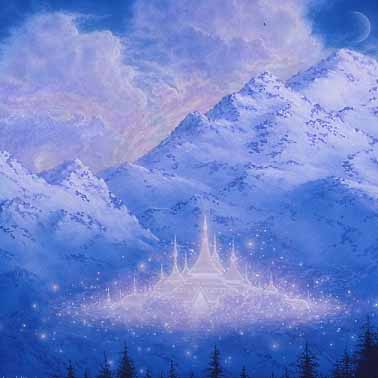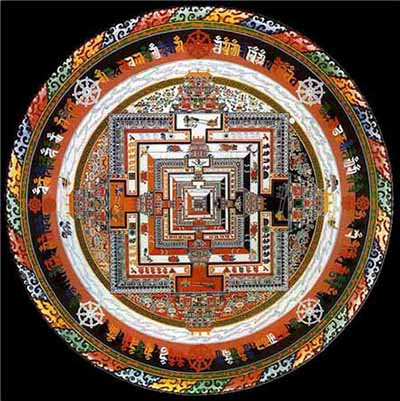

In Tibetan Buddhist tradition, Shambhala (or Shambala) is a mystical kingdom hidden somewhere beyond the snow peaks of
the Himalayas. It is mentioned in various ancient texts including the Kalachakra and the ancient texts of the Zhang Zhung
culture which pre-dated Tibetan Buddhism in western Tibet. The Bon scriptures speak of a closely-related land called Olmolungring.
Shambhala in the Buddhist Kalachakra Teachings
Kalachakra Mandala

The Wheel of Time
Buddha prophecized that all who received the Kalachakra empowerment would take rebirth in its mandala of consciousness.
The Kingdom of Shambhala takes a central place in the Kalachakra teachings. Shambhala (Tib. bde 'byung) is a Sanskrit term
meaning place of peace/tranquility/happiness. Shakyamuni Buddha is said to have taught the Kalachakra tantra on request of
King Suchandra, also the teachings are said to be preserved there. Shambhala is said to be a society where all the inhabitants
are enlightened, centered around a capital city called Kalapa. War and injustice are said to be unknown there, and it is said
to be peopled by beautiful women and men dwelling in magnificent abodes.
Shambhala is ruled over by the Kulika or Kalki (Tib. Ridgen) King, a benevolent monarch who upholds the integrity of the
Kalachakra tantra. Religious scholars believe that this figure developed out of the myth of the Hindu conqueror Kalki, a similar
personage. The Kalachakra prophesizes that when the world declines into war and greed, and all is lost, the twenty fifty Kalika
king will emerge from Shambhala with a huge army to vanquish the corrupt world rulers and usher in a worldwide Golden Age.
Some scholars put this date at 2424 AD.
As with many concepts in Vajrayana Buddhism, the idea of Shambhala is said to have an 'outer,' 'inner,' and 'secret' meaning.
The outer meaning understands Shambhala to exist as a physical place, although only individuals with the appropriate karma
can reach it and experience it as such. There are various ideas about where this society is located, but it is often placed
in central Asia, north of Tibet. The inner and secret meanings refer to more subtle understandings of what Shambhala represents,
and are generally passed on orally.
Western Fascination with Shambhala
During the nineteenth century, Theosophical Society founder H.P. Blavatsky alluded to the Shambhala myth, giving it currency
for Western occult enthusiasts. Later esoteric writers further emphasized and elaborated on the concept of a hidden land inhabited
by a hidden mystic brotherhood whose members labor for the good of humanity.
The myths of Shambhala were part of the inspiration for the tale of Shangri-La told in the popular book Lost Horizon, and
thus some people even refer to Shambhala improperly as if it were a Shangri-La. Shambhala's location and nature remains a
subject of much dispute, and several traditions have arisen as to where it is, or will be, including those that emphasize
it as a non-physical realm that one can approach only through the mind.
Ancient Zhang Zhung texts identify Shambhala with the Sutlej Valley in Himachal Pradesh. Mongolians identify Shambala with
certain valleys of southern Siberia. Beginning in the 1960s, various occult writers have sought to explain the evil of Nazism
by suggesting Adolf Hitler tapped into the malevolent forces of Shambhala when he sent Ahnenerbe researchers to Tibet to measure
Tibetan skulls as part of his master race justifications.Also known that Josef Stalin organized an expedition to find Shambala.
Western Esoteric Traditions
Madame Blavatsky, who claimed to be in contact with a Great White Lodge of Himalayan Adepts, mentions Shambhala in several places without giving
it especially great emphasis. (The Mahatmas, we are told, are also active around Shigatse and Luxor.) Blavatsky's Shambhala,
like the headquarters of the Great White Lodge, is a physical location on our earth, albeit one which can only be penetrated
by a worthy aspirant.
Later esoteric writers like Alice Bailey (the Arcane School) and the Roerichs (Agni Yoga) do emphasize Shambhala. Bailey
transformed it into a kind of extradimensional or spiritual reality. The Roerichs see its existence as both spiritual and
physical.
Related "hidden land" speculations surrounding the underground kingdom of Agartha led some early twentieth-century occultists to view Shambhala as a source of rather negative manipulation by an evil (or amoral)
conspiracy. Nevertheless, the predominant theme is one of light and hope, as evidenced by James Redfield's and Chogyam Trungpa
Rinpoche's respective books by that name.
In Neo-Nazi mysticism, Shambhala is sometimes supposed to be the place to which Adolf Hitler fled after the fall of the
Third Reich. Hitler was known to have an interest in the myth of Shambhala and in "eastern mysticism" generally, from which
he appropriated the swastika.
Reference & Links
Apu Putucusi is a sacred city located adjacent to Machi Piccu and is allegedly linked to Shambhala.

